By Lee Bishop
Early in the morning on May 27, 2015, my wife and I arrived at Skagway, Alaska to ride the 3-foot gauge White Pass & Yukon Railroad. We had arrived on the cruise ship Norwegian Jewel out of Seattle for a round trip to Skagway and stops in between. For me, the White Pass was the highlight of the trip for the activities ashore.
The last time we’d been to Skagway was exactly 15 years before, on our honeymoon. This year, after getting off the ship at the former ore dock on the west side of the harbor, I immediately noticed that a few things had changed since we were there in 2000.
First, the cruise ship passengers no longer apparently meet the train at the end of the gangplank. There is now a bus drop-off point for passengers at a siding several blocks northwest of the dock area and depot.
Second, there is no option to ride the train to the summit well short of the Canadian border and back. Instead, passengers take another activity and either ride the train to Fraser at the official border crossing with British Columbia, or vice-versa. This meant that we were going to ride well beyond where we’d stopped in 2000 to go back to Skagway, but only one-way on the train.
Third, there are several more trains running per day than we saw in 2000. We were later told that as many as six trains head up to and back from Fraser each day.
Fourth, there was no steam running on the day we visited. We were lucky enough to be able to see locomotive 73 coming back into Skagway in 2000, but not so lucky this time. 73 was sitting outside the shops, but with her smokebox cover removed.
Fifth, there seems to be a lot more rolling stock out on the railroad.
Everyone from our ship’s group was assigned to the coach “Nakina River”, a reproduction coach built in 2012 by Hamilton in Burlington, WA. Our coach was in the center of a long line of coaches pulled by GE locomotive numbers 99 and 95.
From our 2000 trip, we learned one of the key lessons when riding the White Pass – always sit on the fireman (left) side of the train, as that’s where 99% of the scenery is. The tracks hug the edge of a horseshoe-shaped route up the valley for most of the trip and heading out of Skagway. Based on this, you don’t see much on the engineer (right) side.
Though the White Pass might be one of the most popular narrow gauge railroads in the US when counting ridership numbers, it isn’t all that well known by train buffs. The line was built as an answer to the incredible suffering experienced on the foot trail from Skagway to the Yukon gold fields during the gold rush of 1898. Completed in 1900 (after the rush had subsided), the White Pass Route was the only way into and out of that section of the Yukon for generations until the Klondike Highway was completed. The line proved instrumental during the construction of the Alaska-Canada Highway and Canol Pipeline, both of which were started in 1942. At that time, the Army’s 770th Railway Operating Battalion took over operational control of the railroad for duration of WW2 and brought in several military locomotives. More locomotives were requisitioned from various railroads in Colorado and Tennessee. Most of these additional locomotives were scrapped at the Northern Pacific yard in Auburn, WA after the war was over. Today, several former White Pass locomotives are running at tourist railroads around the “lower 48” states. The railroad itself modernized with early inter-modal service but traffic waned and the line quit running in 1982. Thankfully the shutdown didn’t last long as the cruise industry soon “rediscovered” Skagway and by 1988, the line was running again, more busy than ever hauling cruise ship passengers. Today, many thousands of people ride the White Pass route each year and it remains possibly the most profitable narrow-gauge railroad in America.
Leaving Skagway to head north to the border, we found the weather to be good considering the time of year. While it was sunny at sea level, low clouds obscured the tops of the mountains until the train climbed above them. The grade is quite impressive, being easily seen from the opposite side of the valley. The grade comes very close to 4% in several places along the route but the head end power was more than capable for the task.
Like all open vestibule coaches, the view from the outside is the best. Unlike in 2000, the other passengers on our coach were very nice and willing to share the view with others. Passengers are not allowed to cross from one coach to another.
Soon, we were passing the abandoned 1901 cantilever bridge over Dead Horse Gulch. Having been bypassed in 1969, the bridge is starting to sag in a few places but is still a very impressive structure.
Once the train crested the pass, it started picking up speed on a slightly downhill run to the border. At this point, the terrain changes dramatically into rocky tundra. Undulating rocky terrain dominated the view for the downhill run to Fraser. Several telephone poles left from the Army’s use of the line still exist at this point.
All too soon, we were slowing down for the crossing at Fraser. Ironically, the Canadian border guards have to inspect everyone’s passports even though the train actually stops right at the border itself. When passengers detrain, they must again have their passports inspected, only 40 feet away from where they had been inspected a few minutes before, just before the bus makes a U-turn to head back into Alaska. The GE locomotives ran around the train to take it back to Skagway. We swapped places with people who’d had their non-railroad portion of the trip already completed.
Fraser houses a small depot and a covered water tank, one of the few original structures still in existence from the completion of the line around 1899. The water tank is used whenever steam locomotives come through.
After a bus ride and other activities in the Skagway area, the driver gave the passengers a chance to get off in downtown Skagway instead of going back to the ship. Most people got off right next to the depot. Due to the tides, we had almost an entire working day in Skagway, the longest shore time at any port during the cruise.
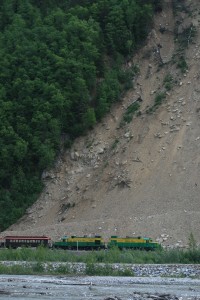
Another passenger run, to the Northeast of Skagway, passing the site of a large landslide while heading southbound.
A walk through the postwar White Pass depot ended with a run through the well-stocked gift shop. A train fan could easily leave Skagway in serious debt if they were allowed to buy anything they want there, but I was able to keep my purchases down to a relatively sane level.
Heading back to the ship on foot with my wife as we always do whenever possible (a tactic that we’ve discovered is a sure-fire way not to gain weight on a cruise), I noticed several spurs around the Skagway area covered in rust. In 2000, those spurs had trains backed up to the docks to the east side of the harbor area.
One Baldwin S118-class 2-8-2 locomotive, number 195, remains on display behind some trees next to the Skagway museum. A rusted hulk in 2000, she was in relatively decent shape this time although she’s missing a lot of her “jewelry” such as builder’s plates, headlight, cab hardware, etc. Number 196 hasn’t fared nearly as well, having been used as fill in the nearby river and pulled out several years later. Her battered, rusted hulk remains lying on her side next to another locomotive in the same condition, behind the Skagway shops. Both were in the exact same position and condition when spotted on our 2000 trip. Several former White Pass boxcars were also spotted in a few back yards around Skagway.
Sadly, none of the people I talked with who interact with the public concerning the railroad had much historical knowledge of it. None knew that the main line passed right down Main Street Skagway until after WW2, nor that several White Pass steam locomotives are in use on other tourist lines (for example, the Dollywood park in Tennessee has an all-former-WP&Y roster) nor even that number 195 on display was a military locomotive. None knew that the Army took over control of the line during the war. During a wait at one stop, our tour bus driver was actually taking notes when I explained some of these things (with the caveat that she should probably look my points up online as she can’t count on one fan being right about everything), much to her credit. Everyone we talked with seemed surprised that we had been there before. It seems that the White Pass rarely gets return visitors due to its remote location.
After getting some shots of their rotary snowplow on display in the downtown area and some switching moves nearby, it was sadly time to head back to the ship.
The White Pass is an amazing railroad, one which is probably ridden by far more general tourists than train fans. This is a real shame, as its one of the most impressive train rides anywhere in the United States. This route should be on any fan’s “bucket list” and I sincerely hope to ride it again someday.
For more info on this amazing railroad, click here for the official website and here for the Wikipedia link.

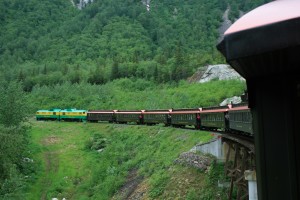
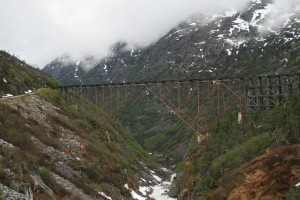
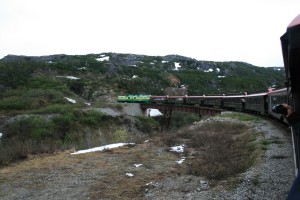
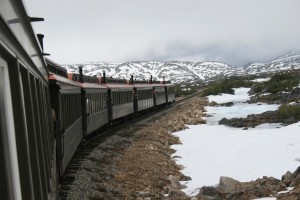
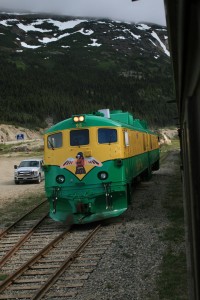
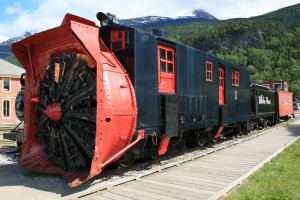
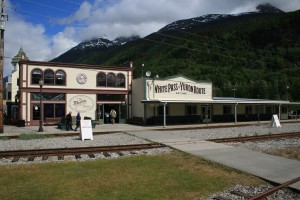
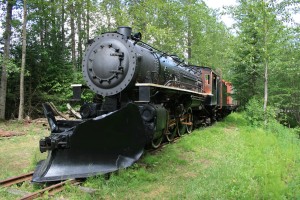
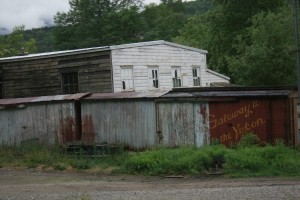
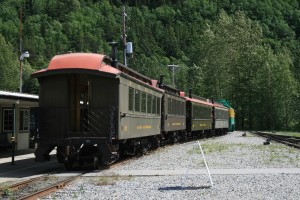
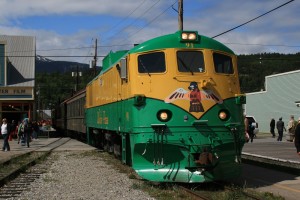
Made the same trip last Sept. Toward the end of the cruise season. Fabulous weather. Only wen to the summit. Train pulled by the old Alcos. Fantastic trip. High point of our cruise. Hope to get back in a few years and ride the extended trip.
– Don Hubbard